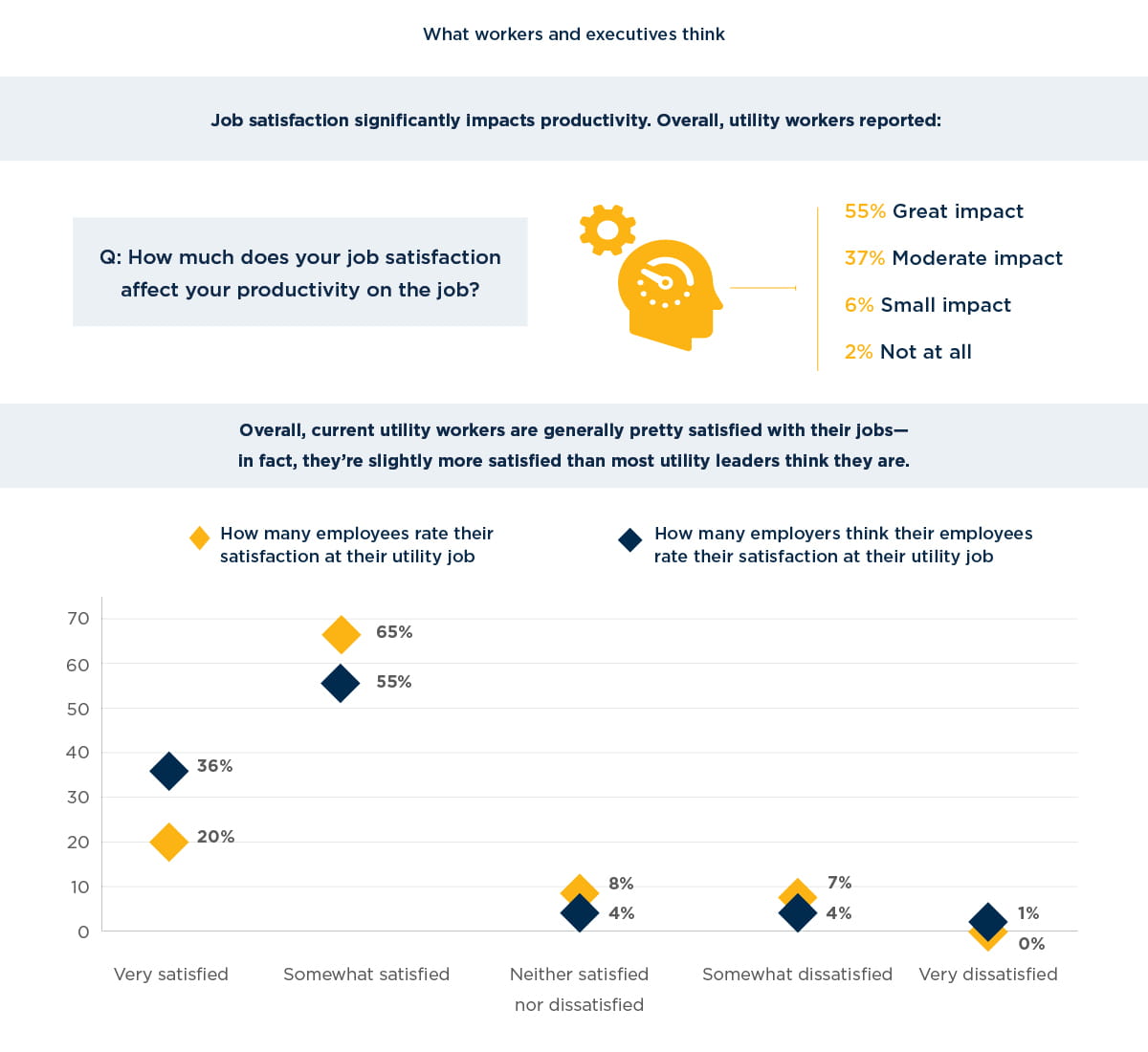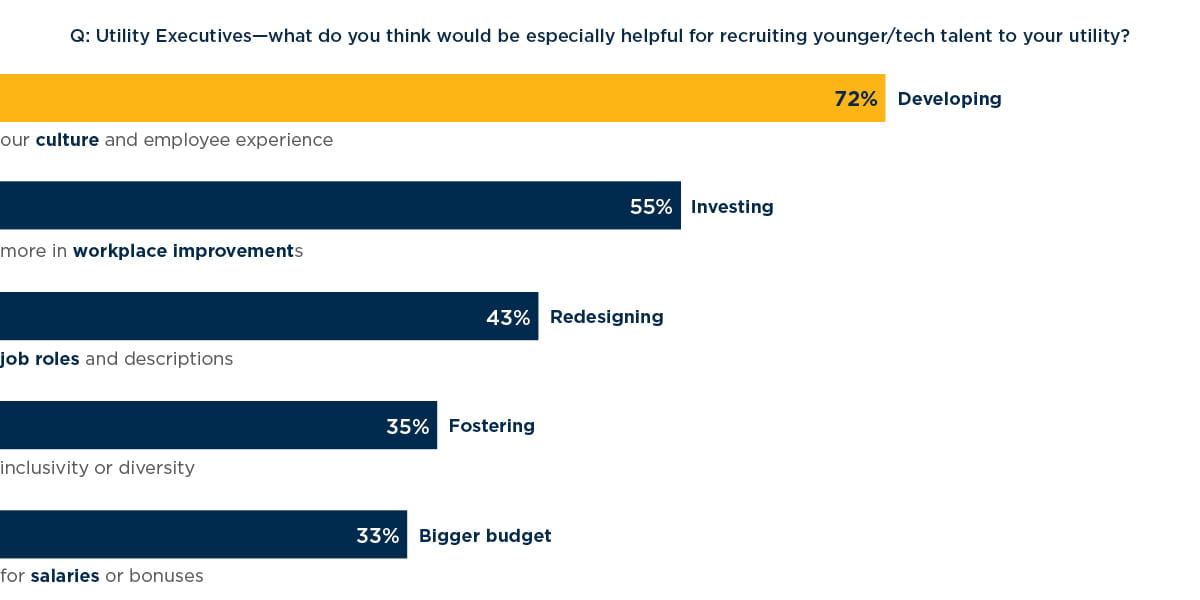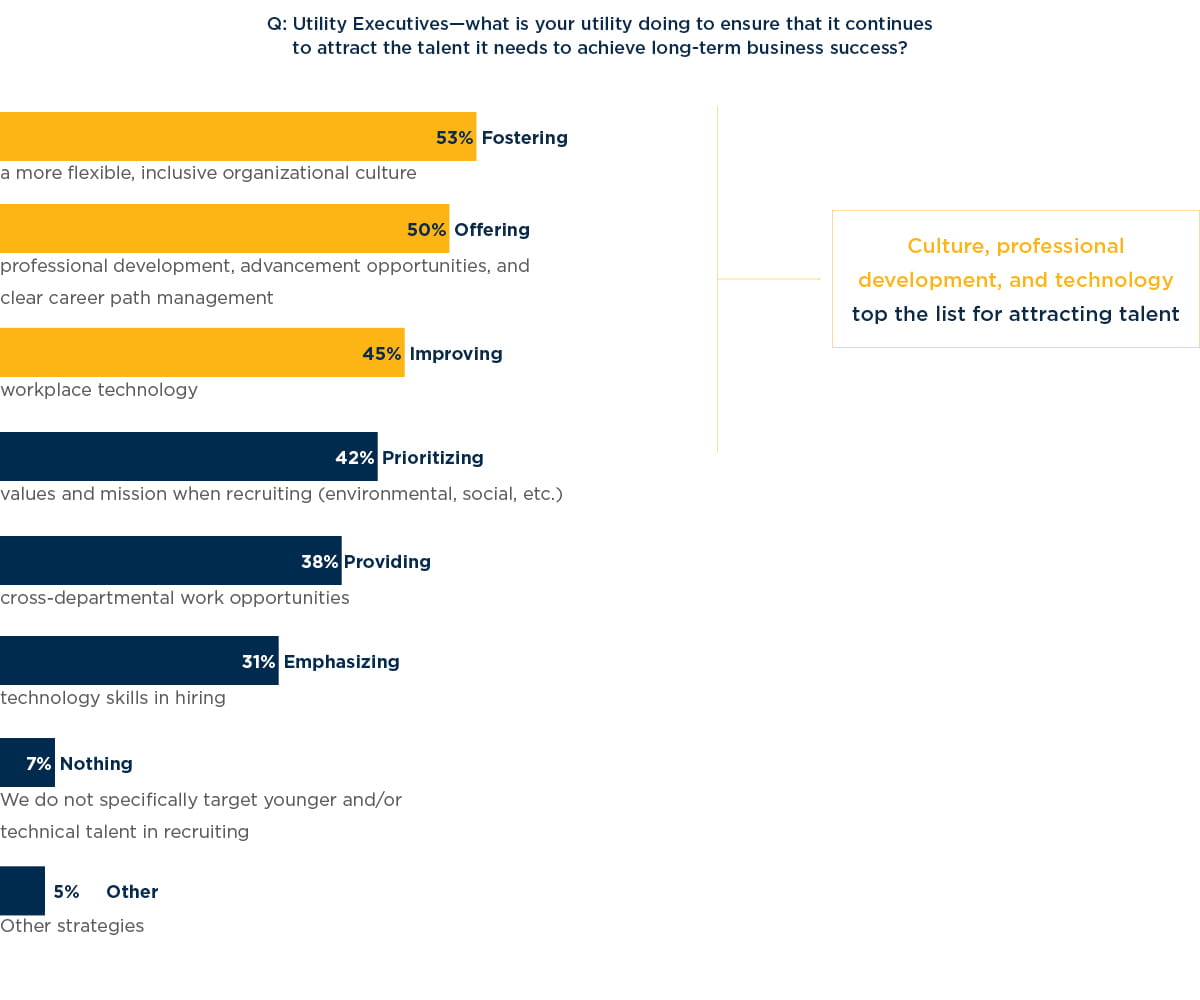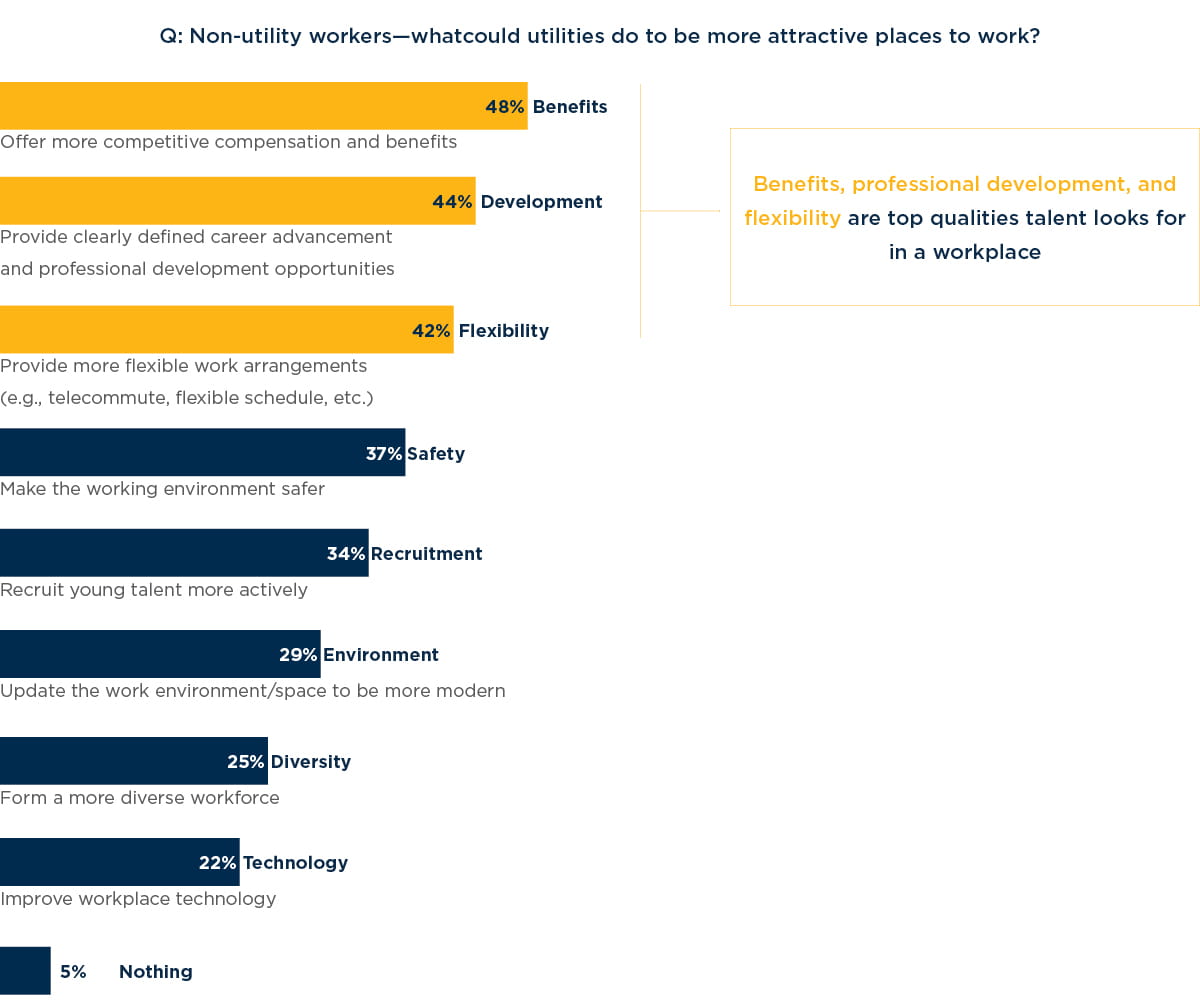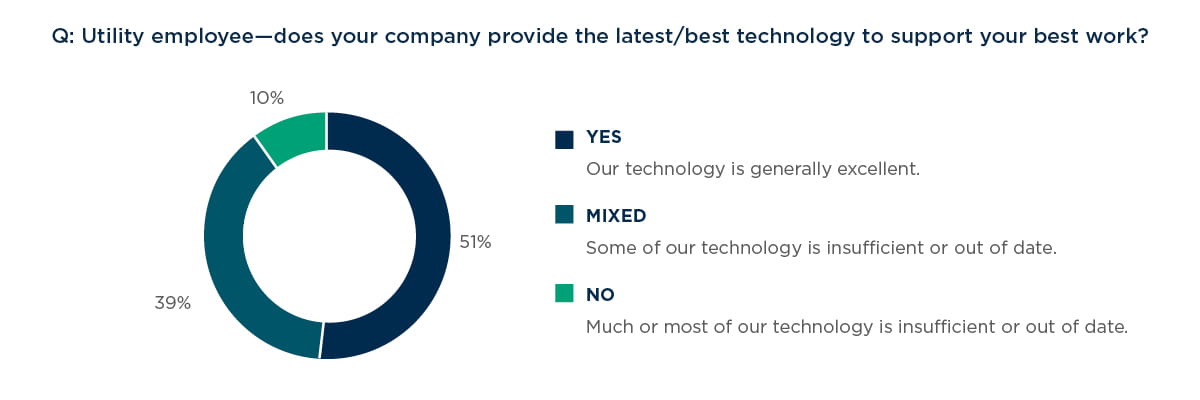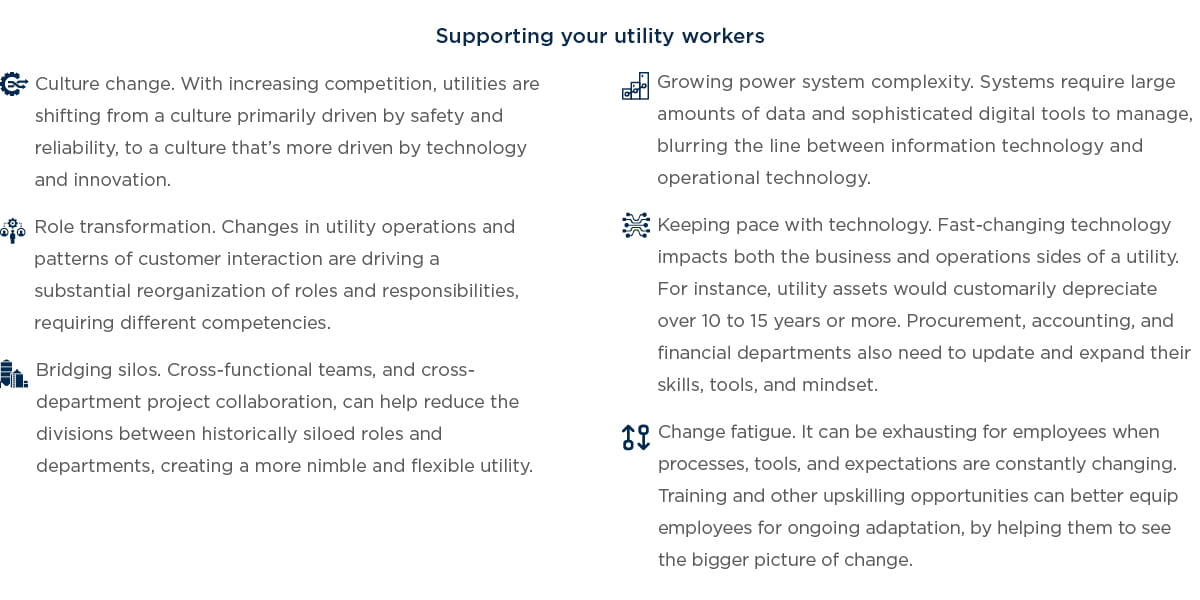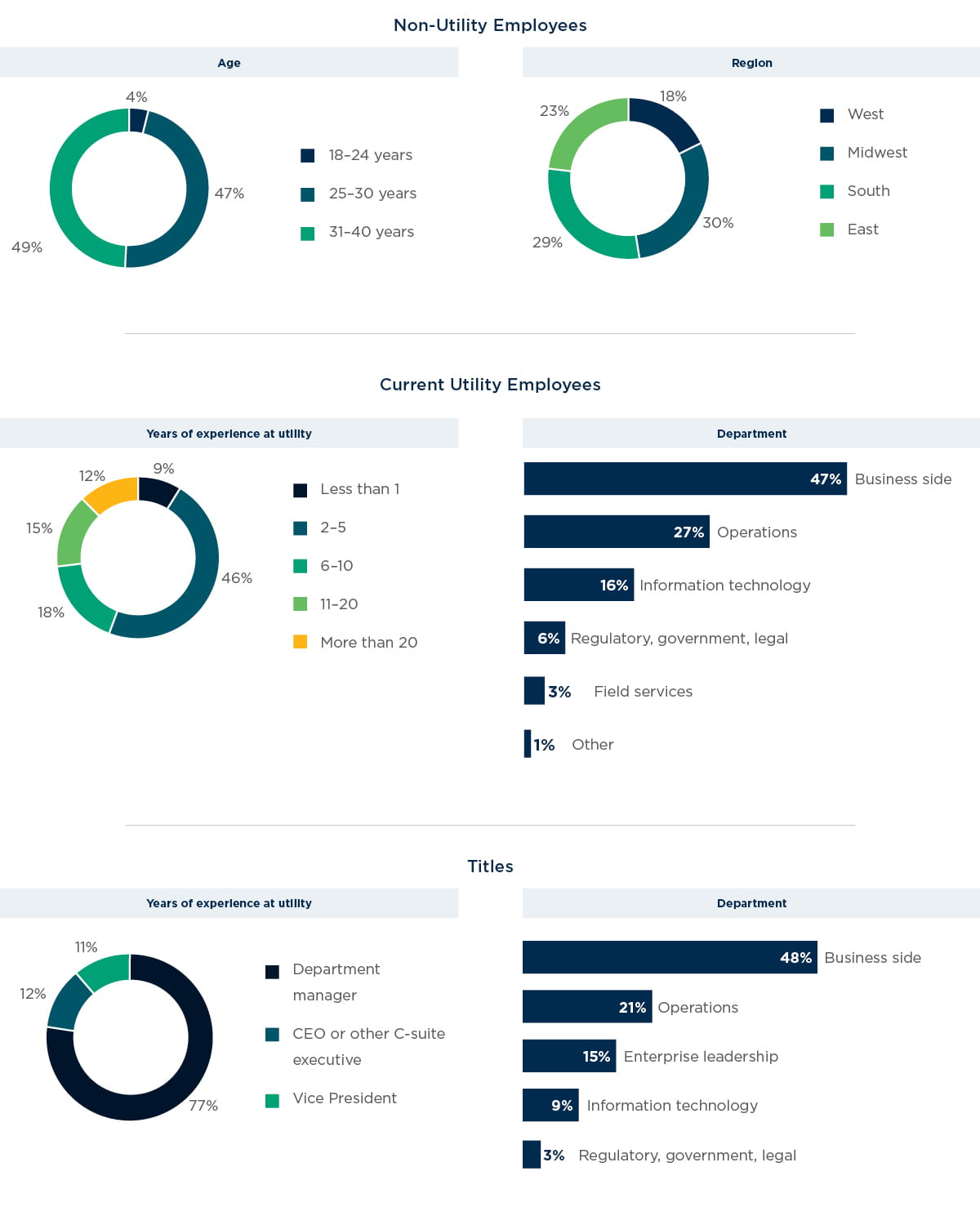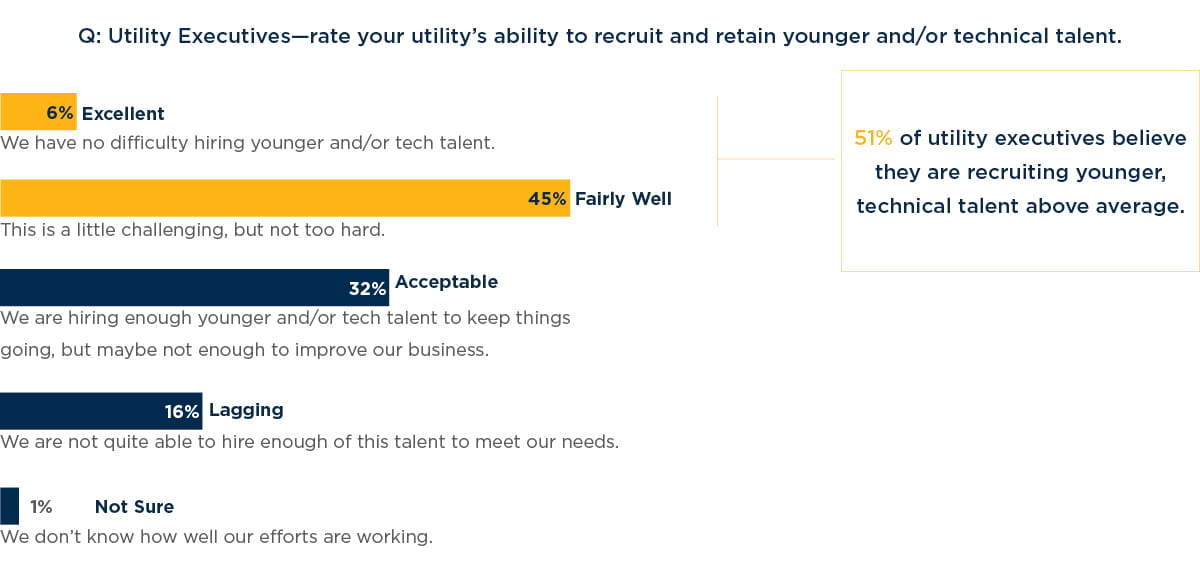
October 2019 | Signature Research
How Utilities Can Win the War for Talent
Utilities are facing challenges to attract and retain the future talent they need. But this also represents an opportunity for utilities to re-envision roles.
In our surveys of utility leaders and employees about the utility workforce and workplace, we found generally high levels of job satisfaction, with some room for improvement. We also found opportunities for cultivating a digitally skilled workforce that can address emerging industry challenges. Key findings include:
- Utility careers have a good reputation. Over 80% of younger non-utility workers view utility careers positively, and nearly 70% would consider working for a utility.
- The utility workforce has generally high satisfaction. Over one-third (36%) of utility workers feel highly satisfied with their jobs, and 55% feel fairly satisfied. This might surprise a few utility leaders: Only 20% of leaders believe their workers feel very satisfied, while 66% believe their workers feel fairly satisfied.
- Real recruiting concerns. A mere 6% of leaders believe their utility is performing excellently at recruiting younger/technical talent. Nearly half (48%) believe their recruiting may not be enough to meet future needs.
- Employee experience might need to be a higher priority for utility leaders. Just over half (52%) listed employee experience as one of their top priorities. Far more listed customer service (78%) and reliability or quality of power service (75%) as top priorities. Utility workers generally felt that leadership priorities should be almost the opposite of what they currently seem to be.
- Employee experience has room for improvement. Over 60% of utility workers indicated that their workplace technology needs at least some updating. Also, 42% of younger non-utility workers said that more flexible working arrangements would make a utility career more attractive.
Introduction
Utilities are facing a number of challenges to attract and retain the talent they need for the future. More digital skills are needed—across all utility roles—to support the product and service innovations that are transforming the industry. Engineers must have data skills to manage
a more dynamic power system. Like other traditional industries, utilities now need to compete for skilled talent with more “attractive” and well-known employers like Amazon and Tesla.
Indeed, the young and digitally savvy talent who are propelling companies into the digital age are not flocking to traditional industries, like utilities, for jobs. Couplethat with the impending retirement of a generation of utility employees, and it’s easy to grasp the looming workforce challenge—where utilities need to attract a highly competitive talent pipeline to execute the industry’s transformational goals.
While this reality is a major challenge, it also represents an opportunity for utilities to re-envision roles, and to emphasize digital skills in the way that they hire, train, and retrain talent. It also represents an opportunity for an increased focus on the employee experience: As utilitieshave been investing heavily to improve their customer experience, they are missing a key ingredient to making these investments work—and that is an increased focus on the employee experience. Why? It’s impossible to separate the employee experience from the customer experience, as employees are often the face and voice of the utility.
Investing in the utility employee experience can yield real business benefits. “We’ve seen the impact it has on organizations,” said Colleen Campbell, director of Operations Excellence at West Monroe. “There’s a huge opportunity to not only improve productivity but also increase retention and improve morale.”
The good news: Utilities are already attractive to potential talent. Research from West Monroe and Utility Dive’s Brand Studio found that most workers who are not currently employed by utilities view utility careers favorably. This good impression, along with a carefully designed employee experience—from recruit to retire—can help utilities win the race for digitally skilled talent.
Chapter 1: The talent challenge: Utilities need a new type of workforce
A wave of digital transformation has alreadyswept many industries. The utility industry has not generally been a first adopter of new digital technologies, but it has become a fast follower, learning from other industries’ experience in how to reap the business benefits of digital transformation.
For over a decade, most utilities have beenapplying more sensors, analytics, and automation to their power system operations. Now they must leverage that data andcomplement it with new workplace technologies—as well as the skilled workers who can innovate new products and services, keep up with emerging technologies, create new efficiencies, and adapt to new energy technologies, while providing excellent customer service.
Meanwhile, power systems are becoming increasingly complex and dynamic, especially as fast-growing renewables challenge grid reliability with intermittent, multidirectional power flows. Also, emerging technologies such as battery energy storage, electric vehicles, and the Internet of Things (IoT) are changing how customers’ loads interact with utilities. Further, the rapid evolutionof consumer and workplace technologies mean that expectations keep rising across all customer classes.
Keeping up with all these changes demands flexibility and adaptability in every utility function—from long-term capital investment strategy, to regulatory compliance,to outage recovery, to the call center, and the ability to operate this new digital utility platform. Digital skills in all areas are essential to support these functions.
The key to successful digital transformation is to invest in people with strong digital skills. In part, this is about utilities hiring more programmers, data analysts, androbotics professionals. It’s also about ensuring that workers, managers, and executives across the enterprise have strong digital skills—such as being proficient and comfortable with tools for collaboration, multichannel communications, geodata, analytics, IT service management (ITSM), mobile work, and the ability to leverage tools like Lean and Six Sigma to insure continuous improvement around key processes in the new digital utility.
A corporate strategy planner for a major Northeast investor-owned utility explained in our survey, “The future of the utility is moving toward a platform business model. The importance of IoT integration and leveraging the data from the platform in decision-making processes are critical. Therefore, analytics, data science, and technologyskills would be more relevant in daily activities. If the utility does not succeed in recruiting tech talent, it would end up having the wire/cable business only—which will not have much growth opportunity.”
So far, many utilities are finding it challenging to hire younger and technical talent. Only 6% of utility leaders believe their organization is accomplishing this task very well.
Younger workers tend to strongly value alignment with the utility’s mission. Nearly one-third of workers with lessthan one year of utility experience said that a top reason for entering the industry was that they “shared they utility’s values or mission.” Across all industries, new employees are most likely to switch jobs quickly (within a year or two) if they don’t immediately find a good fit.
Utilities should consider combining three essential strategies to build tomorrow’s workforce:
Upskilling: Expanding and updating the digital skills of the existing workforce. Done right, digital skills training can help workers feel more engaged with their jobs, as well as more aligned with the utility’s mission. These can greatly enhance job satisfaction and the overall employee experience, increasing retention and yielding a more flexible, adaptable workforce. Highly engaged employees are 36% more likely to stay in the organization.
Redefining roles: Transforming the utility workforce is an opportunity to define roles and departments differently and more flexibly, reflecting a new emphasis on innovation, and allowing more teamwork. Within this structure, employees can pursue new interests and accomplishments while remaining at the utility.
Recruiting: Utilities must hire new talent, especially younger workers and others with strong digital skills.
This can seem daunting during one of the tightest labor markets ever for tech talent, especially since utilities might not appear to be as exciting as technology companies.
“Many utilities are doing a good job of changing perceptions. Through TV ads, smart meters, new services, and better communication with customers, they are permeating the public perception,” said Tom Hulsebosch, senior managing director of Energy & Utilities at West Monroe. “But the answer to the workforce challenge cannot be that you put all of your energy into external marketing. Focusing on employee engagement is just as important.”
Utilities have a strong, positive story to tell in the talent marketplace: that they are immersed in some of the most exciting new technologies, with a mission to serve their communities and the planet.
Chapter 2: Shifting workplace culture to match the excitement of today’s utility
Culture change is one of the most important and most challenging, essential aspects for successful workforce and digital transformation. Historically, most utilities have been fairly siloed organizations, withlow collaboration between business and operational departments, and with limited cross-pollination of skill sets. Career paths have been fairly rigid and linear.Changing these aspects of utility culture offers the promise of positioning utilities well to attract the talent they need to be a successful solution provider.
“Most utilities aren’t telling their story well to talent,” said Mike Rowland, national leader for Customer Experience Strategy at West Monroe. “They usually focus on the stable nature of the business, on safety, and reliability. But in career discussions, this historical framing can undermine their future-oriented story of innovation, excitement, and growth. Stop saying your job is to keep the lights on—It is to help design a 100% clean energy future and the world is counting on us!”
A safety/reliability-driven culture can also be innovation- driven. Innovation can help make utility systems,customers, workers, and the planet even safer—especially since utilities are playing a leading role in decarbonizing the power system, and the renewable energy business is propelled by innovation. Also, utilities can play a leading role in the proliferation of other distributed energy resources and emerging energy technologies, especiallyrooftop and community solar, electric vehicles, microgrids, battery energy storage, and leveraging the Internet of Things for more efficient and reliable home energy use.
And finally, innovation can spark greater responsiveness to changing customer needs and expectations.To accomplish this, both the business and operational sides of utilities must transform. “Utilities used to mainly be energy providers. They’ve evolved to become solution providers, helping customers use energy more efficiently and differently,” said Jodi Bednar, director of the Energy and Utilities practice at West Monroe. “To succeed, utilities need to ground themselves and focus on the customer experience—especially since they face new competitors in the evolving space of distributed energy resources.”
Culture change is at the top of utility leaders’ list of their current strategies to fill the looming talent gap. Just over half (53%) said that their utility is working to foster a more flexible, inclusive organizational culture. Similarly, 72%of utility leaders believe that “developing our culture andemployee experience” would be especially helpful for recruiting younger/tech talent.
At the same time, a majority (62%) of utility leaders believe their organization’s current workplace culture is attractive to the talent that is needed for the future, rather thanthe talent they already have. This perhaps indicates a bit of cognitive dissonance about the current state and usefulness of organizational culture that utility leaders might want to consider more closely.
Chapter 3: What do younger workers want? Innovation, flexibility, and stability
As utilities court younger and technical talent, it helps to understand how younger workers not yet in this industry view careers and employers. “Younger workers want to work to live, not live to work,” Bednar said. “They want to be engaged. They want to work for a company that aligns with their values and priorities.”
Even though most utility employees feel pretty satisfied at work, most don’t believe that the leaders of their organization value the employee experience highly enough. When utility employees were asked to rank theirpreferred priorities for leadership versus what they perceive as leaders’ existing priorities, there was a striking disparity in how employee experience was ranked.
This disconnect indicates that perhaps utility leaders need a clearer understanding of how a great employee experience supports customer satisfaction, and thus business success—and they should emphasize the importance of this connection to both existing and prospective future talent.
“Utility leaders focusing on capital spending without focusing on employee experience keeps them from having a good story to tell new talent,” Rowland observed. “Italso can trap them in older technologies and platforms. Leaders should be setting the vision, which gives recruiters something better to use.”
Although millennials (people aged 23-38 in 2019) have a reputation for being more interested in adventure and risk- taking, West Monroe’s research reveals that the millennials who view utility careers more positively tend to have rather simple reasons for this. The two most popular responses were:
- 64%: Competitive compensation and benefits
- 50%: I feel I could have a long-term career there
Many millennials have had to deal with disruption and instability their whole lives, but especiallyduring the economic downturn that began in 2008. Consequently, many organizations courting younger talent could be underestimating the segment of the millennial demographic that desires some stability and advancement—along with innovation, creativity, and engagement. Consequently, for some millennials, utilities’ reputation for stability might compare favorably to tech companies, which tend to be more volatile.
“Additionally, millennials are a value-driven generation. Utilities can be about providing a more sustainable future and focusing on community values,” said Colleen Campbell. “This attracts the younger generation if they see themselves as part of a larger more important conversation. You can accomplish this through employee experience weaved into the culture and community goals.”
Adapting non-traditional working arrangements might also help lure younger workers. For instance, 42% of non-utility workers would view utility careers even more favorablyif utilities offered more options for telecommuting and flexible schedules. To some extent, modernizing the technology that utility employees use on the job could support greater work flexibility.
Finally, one-third simply want to be approached: Utilities should recruit young talent more actively.
Chapter 4: Engaging recruiting and retention through branding, training, and technology
With the U.S. unemployment rate for tech talent at a 20-year low, utilities must be innovative about howthey compete effectively for talent. Nearly half of utility leaders surveyed had some difficulty hiring younger and digital workers.
Creative recruiting is especially important for utilities that are smaller, or outside major metro areas. Younger and techtalent has been migrating to big cities, as well as smallerprogressive tech hubs. “It’s important for smaller utilities toget very creative about working with their communities,before new talent enters the workforce,” Bednar said. “Plant those seeds early and show that there are excellent opportunities for younger talent to find fulfilling work where they live.”
Employer branding
Employer branding is an increasingly important aspect oftalent acquisition where many utilities appear to be laggingbehind tech companies (as well as other critical industries, such as banking and telecommunications). An employer brand is an organization’s reputation as a place to work,as well as the value proposition it offers to existing and prospective employees.
Effective employer branding starts with the existing workforce. Utilities can engage their employees in sharing.
- Why they chose a utility career
- Why they stay
- The kind of future they’re working together to build
When employees share these insights, individually and together, it can help utilities craft forward-looking storiesabout utility careers that are compelling to new talent. This exercise can help foster camaraderie and loyalty within the workforce, and it also can yield positive ripple effects beyond the utility.
“Employees talk to everyone,” Rowland said. “Utilities often pay millions in advertising just to reinforce their current state. They need to shift that conversation toward the future.”
Employer branding that touts innovation, support for employees, community involvement, and opportunity for creativity and advancement is commonly featured on company career websites in many industries. By contrast,the career websites of most utilities tend to be just a listing of jobs, rather than a compelling call to action. One notable exception is Edison International’s careers site, featuring the forward-looking message: “Build a career and a clean energy future.”
Employer branding strategies are only successful when they accurately reflect the employer experience. When companies present employer brand messaging that doesn’t match what current employees have to say (especially on employer review sites such as Glassdoor), their employer brand will suffer.
“Interjecting your organization values into your messaging will attract the like-minded millennials,” Campbell said. “Ensure your branding message clearly touts the benefits but at the same time doesn’t overpromise. That could lead to retention challenges down the road.”
Finding more compelling, forward-looking stories to tell about utility careers applies to all utilities, including smaller ones. “With the migration of talent to the cities,rural co-ops need to be extremely innovative on working with universities, high schools, economic development agencies, and even agricultural extensions in their area,” Bednar said. “They can make a strong case for why people should work in the communities where they live.”
It also helps for utility staff to be engaged in the community, especially with universities. For instance, many utilities have partnered with universities to turn campus energy projects (such as microgrids and smart streetlighting) into “living learning labs,” mostly for mechanical and electrical engineering students. So far, few of these collaborations have actively reached out to include students of computer science, cybersecurity, and data analysis. However, those future digital workers could participate in creating models, algorithms, monitoring, and other digital facets of campus energy projects—while engaging directly with utility staff and learning about utility careers.
Training
Expanding the capacity of existing talent can be as important to workforce transformation as hiring new talent. Workers value opportunity for advancement, including workers who might wish to expand their skill set or responsibilities in a more digital direction. West Monroe found that training is the most common way that utilities encourage employees to reach their full potential at work.
Training is another essential part of talent retention, as well as recruitment. New and existing utility workers often welcome opportunities for training in programming, cloud services, machine learning, data analysis, networking, cybersecurity, and other digital skills. Similarly, cross- disciplinary project teams (such as partnering engineers with programmers and data analysts) can support motivation to develop new skills—especially if this can increase an employee’s opportunity for advancement.
Some employers are reluctant to offer training in a tight labor market, fearing that employees will take their new skills and go elsewhere. However, the downside of not upskilling employees can be considerable. An old joke that’s popular with digital workers makes this point:
CFO to CTO: “What if we train our employees, and they leave?”
CTO to CFO: “What if we don’t, and they stay?”
Workplace technology
The tools that employees use at work are a rich opportunity to enhance employee engagement and the employee experience. When these tools are not just easy to use,but also effective, efficient, and flexible, they enable employees to accomplish more while struggling less. Digital transformation is essential not only for achieving operational, business, and customer services goals—it can help utilities compete effectively for talent.
“To keep employees satisfied, utilities must reduce redundant manual tasks that don’t add value, but ratherempower them to be more impactful to the utility’s mission and customers,” Hulsebosch said. “A more digital workplace is great way to achieve that.”
Done poorly, digital transformation can have negative impacts, perhaps even worse than never attempting to update technology in the first place. One employee from a major Southeastern public power agency shared this experience:
“Technology is one of our biggest drags on progress. Our financial services organization is going through a digital transformation.But without an enterprise strategy on data governance, management, andarchitecture, we are still struggling with legacy, inconsistent processes. It will be difficult forustotruly make progress with analytics maturity and newtechnology tools if we are constantly struggling with siloed, inconsistent data.
We are a very large company. Even if we make huge improvements with our financial services data, we report on and analyze data from other parts of the enterprise—so it will continue to be a struggle. Meanwhile, our groups that manage and operate generation plants are even further behind technologically. They’re relying on Excelspreadsheets, with none of their data connected to a database or digital repository.”
Only 12% of utility employees said their organization offers employees access to the best technology. Meanwhile,less than half (45%) of utility leaders reported that their workforce transformation strategy features workplace technology improvements.
Updating the digital tools that utility workers use on a daily basis (desktop software, mobile devices and apps, and services that support both) can be a powerful way to enhance the employee experience, thus supporting both recruiting and retention. Currently, many utilities still rely primarily on email, file-sharing servers, or vastly outdatedsoftware for internal communication and collaboration. Too often, these tools are integrated poorly or not at all.
“Younger employees don’t want to have to log into four different systems to do a single job,” Rowland said.
Similarly, Campbell recalled, “One utility was losing young people. They’d bring them in as interns, but they wouldn’t stay because of the technology gap. Their collaboration tools were old and stodgy.”
Newer tools, such as Slack, secure text chat, webinars, and on-demand learning can empower employees andteams to be creative and mutually supportive, and to make decisions quickly. These can be coupled with analytics, workflow management tools to automate lower-level tasks, and service management platforms that identify and meet emerging workforce needs.
Digital transformation can also improve organizational culture and efficiency by helping utilities bridge their historic silos. Campbell suggests that utilities should map out how employees give and receive information across the organization, especially between groups and departments. What are the flows, and how many tools and steps are involved? Can people connect quickly to resolve issues, including from the customer contact center?
“If you stay in your silo and don’t know what’s happening elsewhere, your organization will be less effective,” Campbell said.
Updated workforce technology yields better, faster, and more accurate customer service and operations. “Costs go down and customer satisfaction goes up,” Rowland said. “Regulators are beginning to pay attention to customer experiences and how utilities are helping their customers.”
From a strategic perspective, training and otherwise supporting existing utility workers in gaining skills and experience that are more digital and diverse, coupled with hiring more young/digital workers, can help utilities address a variety of ongoing challenges related to the employee experience.
Conclusion: Building a 21st century utility workforce
People are ultimately the most valuable asset of any utility. They not only purchase equipment and keep systems running; they possess the knowledge, skills, and creativity to enable utilities to survive andthrive amid ongoing industry disruption. They know how to keep utility customers happy, because they are also utility customers.
“If you want to take care of your customer, you need to take care of your people—who are taking care of your customers,” said Hulsebosch.
Customers are crucial external stakeholders in utilities. Generally, more satisfied customers cost less to serve. Also, regulators (another crucial external stakeholder) typically pay close attention to customer satisfaction along with the effectiveness of the utility’s service. Thus, fostering anexcellent utility employee experience can improve a utility’s fortunes outside as well as inside the enterprise. When employees are more engaged, they communicate and collaborate better with stakeholders and they ensure that the utility is optimizing its resources to maximize the value of its services. That makes it easier for stakeholders to see themselves as part of a team.
While it’s important for utilities to attract millennial talent, they also should not overlook the value that workers over 40 can provide. Across North America, people are retiring later, and often changing careers after age 40. Older workers can offer valuable insight and practical experience, enthusiasm for a fresh challenge (including learning new digital skills), and loyalty sparked by a renewed sense of mission. Utilities located in regions that are less attractive to millennial digital workers might especially benefit from an age-diverse recruiting strategy.
Improving the manager experience is probably the best, and most cost-effective, way to improve the employee experience. New research from Gallup found that managersare the linchpin of a great employee experience—and that learning the top challenges of being a manager can help you improve manager engagement.
People will leave a utility, or stay, because of their manager. Examine the effectiveness of your managers and start measuring it. Support managers with information,tools, and training to improve their style for supporting employees and teams, giving and receiving feedback.
Utilities’ generally positive reputation in the talent marketplace is a good foundation for updating and strengthening their strategy for talent acquisition and management. A positive first step along this path is for utilities to stop underestimating their own relative state of digital maturity, compared to other industries.
The war for talent is not a check-the-box issue. From the implementation of new technologies, to employeeengagement and upskilling, to change management, it is an ongoing battle that must be tackled from top to bottom. And West Monroe is uniquely positioned to help utilities face these challenges head-on.
“The utility industry may have a bit of an undeserved inferiority complex about its ability to compete for digital talent,” Hulsebosch said. “But we can do this. Utilities can transform to become people-first organizations—which encompass safety, customers, and employees as top priorities. That can be the legacy of today’s utility leaders.”
Survey methodology
West Monroe and Utility Dive’s Brand Studio surveyed three groups critical to gaining an in-depth understanding of the utility workforce transformation challenge: utility leadership, utility workers, and non-utility workers under age 40.
